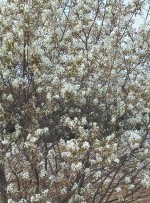 This deciduous tree is native to eastern North America from Nova Scotia and Ontario, south to Georgia and west to Kansas where it grows in woodland edges, thickets, rock outcroppings, and roadsides. It is a member of the rose family, Roseaceae, that also includes cherries, lady’s mantel, and Pyracantha. The plants may be single stemmed or clumping and have a medium texture. The stems are reddish brown turning silver to charcoal-gray with age, and the elliptical 1 ¼-3” long leaves emerge with a purplish tinge in the spring before turning gray-green in the summer and orange to red in the fall. Fragrant white five petaled flowers are carried in pendulous racemes in early spring before the leaves for a brief display from one day to one week. The flowers are followed by edible red berries ripening to dark blue in early summer and appealing to birds. Allegheny serviceberry is used as a specimen, shade tree, or tall hedge when pruned or sheared. A good choice for woodland, native, or bird gardens. Several cultivars are available that vary most significantly in width. The genus name Amelanchier comes from the French Provincial name for a related tree. The specific epithet laevis is the Latin word meaning smooth or hairless and refers to the stem or foliage.
This deciduous tree is native to eastern North America from Nova Scotia and Ontario, south to Georgia and west to Kansas where it grows in woodland edges, thickets, rock outcroppings, and roadsides. It is a member of the rose family, Roseaceae, that also includes cherries, lady’s mantel, and Pyracantha. The plants may be single stemmed or clumping and have a medium texture. The stems are reddish brown turning silver to charcoal-gray with age, and the elliptical 1 ¼-3” long leaves emerge with a purplish tinge in the spring before turning gray-green in the summer and orange to red in the fall. Fragrant white five petaled flowers are carried in pendulous racemes in early spring before the leaves for a brief display from one day to one week. The flowers are followed by edible red berries ripening to dark blue in early summer and appealing to birds. Allegheny serviceberry is used as a specimen, shade tree, or tall hedge when pruned or sheared. A good choice for woodland, native, or bird gardens. Several cultivars are available that vary most significantly in width. The genus name Amelanchier comes from the French Provincial name for a related tree. The specific epithet laevis is the Latin word meaning smooth or hairless and refers to the stem or foliage.
Type: Deciduous flowering tree
Outstanding Features: Flowers, fruit
Form: Rounded canopy
Growth Rate: Rapid
Bloom: Fragrant five-petaled white flowers in pendulous racemes in early spring for brief bloom time
Size: 15-40’ H x 10-40’ W
Light: Full sun to partial shade
Soil: Average, medium moist, well-drained
Hardiness: Zones 4-8
Care: Low maintenance
Pests and Diseases: Susceptible to scale, aphids, powdery mildew, rust, canker, fire blight, leaf spot
Propagation: Seed
Cultivars:
‘Cumulus’ (reduced horizontal branching to 20’ width)
‘Prince Charles’
‘R.J. Hilton’
‘Snowcloud’ – (a fastigiate form with width of 15’)